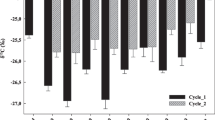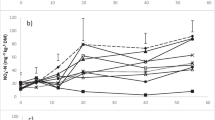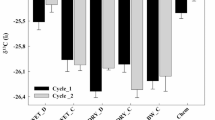Abstract
This experiment aimed to look at active and passive soil organic carbon percentages during composting different agricultural wastes at different temperatures. It is essential to understand how various agricultural wastes composting oxidase the carbon (C) during decomposition at various temperatures. The highest C content in the crop residce was recorded in the gliricidia (42.1) and the lowest in the cotton stalk (36.2), while the highest temperature (41.35 °C) recorded during the decomposition in the (T4) 40% wheat (Triticum aestivum) straw (WS) + 40% cotton (Gossypium hirsutum) stalk (SCS) + gliricidia (Gliricidia sepium) leaf (GL) at 70 days and the lowest temperature (20.25 °C) in the T1 100% WS at 119 days. The experimental pits comprising six treatments were laid out in a completely randomized design with four replications. Treatments were as follows: (T1) 100% WS; (T2) 100% SCS; (T3) 50% WS + 50% SCS; (T4) 40% WS + 40% SCS + GL; (T5) 30% WS + 30% SCS + 20% GL + 20% sorghum (Sorghum bicolour) stubbles (SS); and (T6) 25% WS + 25% SCS + 25% GL + 25% SS. This study showed that with an increase in the decomposition period, the C pools significantly had higher levels of very labile content (18.64 g kg–1) and labile content (5.65 g kg–1). Less labile content (0.45 g kg–1) was recorded in T6, whereas the highest non-labile content (37.98%) was recorded in T1. These C pools reached their maximum concentrations at the last phase of T6 decomposition. This work therefore provides a roadmap for further research into the science of soil organic carbon fractions (active and passive) during composting at various temperatures. The experiment’s hypothesis may offer a guidance on strategies and techniques for appropriate decomposition methodology of agricultural waste, as well as the function of enriched materials. It will be useful for researchers, producers, and planners to know the organic C fractions in composts of agricultural wastes at different temperatures and stages.





Similar content being viewed by others
Data Availability
Most of the data are available in all tables and figures of the manuscripts.
References
Almeida RF, Silveira CH, Mikhael JER, Franco FO, Ribeiro BT, Ferreira AS, Mendonça ES, Wendling B (2014) CO2 emissions from soil incubated with sugarcane straw and nitrogen fertilizer. Afr J Biotechnol 13:3376–3384. https://doi.org/10.5897/AJB2014.13790
Balota EL, Calegari A, Nakatani AS, Coyne MS (2014) Benefits of winter cover crops and no-tillage formicrobial parameters in a Brazilian Oxisol: a long-term study. Agric Ecosyst Environ 197:31–40. https://doi.org/10.1016/j.agee.2014.07.010
Banerjee A, Jhariya MK, Yadav DK, Raj A (2020) Environmental and sustainable development through forestry and other resources. Apple Academic Press Inc. 400 pp. Paperback ISBN: 978–1–77463–503–2
Banerjee A, Meena RS, Jhariya MK, Yadav DK (2021) Agroecological footprints management for sustainable food system. Springer, Singapore. https://link.springer.com/book/https://doi.org/10.1007/978-981-15-9496-0
Banger K, Toor G, Biswas A, Sidhu S, Sudhir K (2010) Soil organic carbon fractions after 16 years of applications of fertilizers and organic manure in a Typic Rhodalfs in semi-arid tropics. Nutr Cycl Agroecosyst 86:391–399. https://doi.org/10.1007/s10705-009-9301-8
Baudoin E, Benizri E, Guckert A (2003) Impact of artificial root exudates on the bacterial community structure in bulk soil and maize rhizosphere. Soil Biol Biochem 35:1183–1192. https://doi.org/10.1016/S0038-0717(03)00179-2
Belay-Tedla A, Zhou X, Su B, Wan S, Luo Y (2009) Labile, recalcitrant, and microbial carbon and nitrogen pools of a tallgrass prairie soil in the US Great Plains subjected to experimental warming and clipping. Soil Biol Biochem 41:110–116. https://doi.org/10.1016/j.soilbio.2008.10.003
Benbi DK, Richter J (2002) A critical review of some approaches to modelling nitrogen mineralization. Biol Fertil Soils 35(3):168–183. https://doi.org/10.1007/s00374-002-0456-6
Bhuvaneshwari S, Hettiarachchi H, Meegoda JN (2019) Crop residue burning in India: policy challenges and potential solutions. Int J Environ Res Public Health 16:832. https://doi.org/10.3390/ijerph16050832
Bindu SM, Manan J (2018) Ways and means of paddy straw management: a review. J Rev Agric Allied Fields 1(1):1–12
Chan KY, Bowman A, Oates A (2001) Oxidizable organic carbon fractions and soil quality changes in an oxicpaleustalf under different pasture leys. Soil Sci 166:61–67. https://doi.org/10.1097/00010694-200101000-00009
Chim Chan O, Casper P, Sha LQ, Feng ZL, Fu Y, Yang XD, Ulrich A, Zou XM (2008) Vegetation cover of forest, shrub and pasture strongly influences soil bacterial community structure as revealed by 16S rRNA gene T-RFLP analysis. FEMS Microbiol Ecol 64:449–458. https://doi.org/10.1111/j.1574-6941.2008.00488.x
Das A, Patel DP, Lal R, Kumar M, Ramkrushna GI, Layek J, Buragohain J, Ngachan SV, Ghosh PK, Choudhury BU, Mohapatra KP (2016) Impact of fodder grasses and organic amendments on productivity and soil and crop quality in a subtropical region of eastern Himalayas, India. Agric Ecosyst Environ 216:274–282. https://doi.org/10.1016/j.agee.2015.10.011
Ding X, Han X, Liang Y, Qiao Y, Li L, Li N (2012) Changes in soil organic carbon pools after 10 years of continuous manuring combined with chemical fertilizer in a Mollisol in China. Soil Till Res 122:36–41. https://doi.org/10.1016/j.still.2012.02.002
Franzluebbers AJ, Haney RL, Honeycutt CW, Arshad MA, Schomberg HH, Hons FM (2001) Climatic influences on active fractions of soil organic matter. Soil Biol Biochem 33:1103–1111. https://doi.org/10.1016/S0038-0717(01)00016-5
Garbeva PV, Van Veen JA, Van Elsas JD (2004) Microbial diversity in soil: selection of microbial populations by plant and soil type and implications for disease suppressiveness. Annu Rev Phytopathol 42:243–270. https://doi.org/10.1146/annurev.phyto.42.012604.135455
Ghosh A, Bhattacharyya R, Meena MC, Dwivedi BS, Singh G, Agnihotri R, Sharma C (2018) Long-term fertilization effects on soil organic carbon sequestration in an Inceptisol. Soil Tillage Res 177:134–144. https://doi.org/10.1016/j.still.2017.12.006
Goh KM (2004) Carbon sequestration and stabilization in soils implications for soil productivity and climate change. Soil Sci Plant Nutr 50:467–476. https://doi.org/10.1080/00380768.2004.10408502
Gomez KA, Gomez AA (1983) Statistical procedures for agricultural research (2 ed.). John wiley and sons, NewYork, 680p
Gu C, Liu Y, Mohamed I, Zhang R, Wang X, Nie X, Jiang M, Brooks M, Chen F, Li Z (2016) Dynamic changes of soil surface organic carbon under different mulching practices in citrus orchards on sloping land. PloS one 11(12):e0168384. https://doi.org/10.1371/journal.pone.0168384
IPCC (2014) Inter-governmental panel on climate change- assessment report 5. IPCC. https://www.ipcc.ch/report/ar5/wg2
Jain N, Bhatia A, Pathak H (2014) Emission of air pollutants from crop residue burning in India. Aerosol Air Qual Res 14:422–430. https://doi.org/10.4209/aaqr.2013.01.0031
Jat HS, Datta A, Choudhary M, Sharma PC, Jat ML (2021) Conservation agriculture: factors and drivers of adoption and scalable innovative practices in Indo-Gangetic plains of India–a review. Int J Sustain Agric Res 19:40–55. https://doi.org/10.1080/14735903.2020.1817655
Kaushal R, Tewari S, Thapliyal SD, Kumar A, Roy T, Islam S, Lepcha STS, Durai J (2021) Build-up of labile, non-labile carbon fractions under fourteen-year-old bamboo plantations in the Himalayan foothills. Heliyon 7:e07850. https://doi.org/10.1016/j.heliyon.2021.e07850
Kirschbaum MU (2000) Will changes in soil organic carbon act as a positive or negative feedback on global warming? Biogeochemistry 48:21–51. https://doi.org/10.1023/A:1006238902976
Kumar A, Yadav BR, Singh SK, Pathak H (1998) Effect of mixed industrial effluent on properties of ground water and irrigated soils. J Indian Soc Soil Sci 46:427–429
Lal R (2004) Soil carbon sequestration to mitigate climate change. Geoderma 123:1–22. https://doi.org/10.1016/j.geoderma.2004.01.032
Lal M, Singh KK, Rathore LS, Srinivasan G, Saseendran SA (1998) Vulnerability of rice and wheat yields in NW India to future changes in climate. Agric for Meteorol 89:101–114. https://doi.org/10.1016/S0168-1923(97)00064-6
Liao C, Li D, Huang L, Yue P, Liu F, Tian Q (2020) Higher carbon sequestration potential and stability for deep soil compared to surface soil regardless of nitrogen addition in a subtropical forest. Peer J 8:9128–9128. https://doi.org/10.7717/peerj.9128
Lohan SK, Jat HS, Yadav AK, Sidhu HS, Jat ML, Choudhary M, Peter JK, Sharma PC (2018) Burning issues of paddy residue management in north-west states of India. Renew Sust Energ Rev 81:693–706. https://doi.org/10.1016/j.rser.2017.08.057
Lopez-Capel E, Krull ES, Bol R, Manning DA (2008) Influence of recent vegetation on labile and recalcitrant carbon soil pools in central Queensland, Australia: evidence from thermal analysis-quadrupole mass spectrometry-isotope ratio mass spectrometry. Rapid Commun Mass Spectrom 22:1751–1758. https://doi.org/10.1002/rcm.3538
Lundquist EJ, Jackson LE, Scow KM, Hsu C (1999) Changes in microbial biomass and community composition, and soil carbon and nitrogen pools after incorporation of Rye into three California agricultural soils. Soil Biol Biochem 31:221–236. https://doi.org/10.1016/S0038-0717(98)00093-5
Meena RS, Kumar S (2022) Soil quality protection policies and plans to ensure sustainability. In: Reference Module in Earth Systems and Environmental Sciences. https://doi.org/10.1016/B978-0-12-822974-3.00120-8
Meena RS, Pradhan G (2023) Industrial garbage-derived biocompost enhances soil organic carbon fractions, CO2 biosequestration, potential carbon credits and sustainability index in a rice-wheat ecosystem. Env Res. https://doi.org/10.1016/j.envres.2023.116525
Meena RS, Kumar S, Datta R, Lal R, Vijayakumar V, Brtnicky M, Sharma MP, Yadav GS, Jhariya MK, Jangir CK (2020a) Impact of Agrochemicals on Soil Microbiota and Management: a Review Land 9:34. https://doi.org/10.3390/land9020034
Meena RS, Lal R, Yadav GS (2020b) Long-term impact of topsoil depth and amendments on carbon and nitrogen budgets in the surface layer of an Alfisol in Central Ohio. Catena 194:104752. https://doi.org/10.1016/j.catena.2020.104752
Meena, RS, Kumar S, Sheoran, S, Jhariya, MK, Bhatt R, Yadav GS, Gopinath KA, Rao CS, Lal R (2021) Soil organic carbon restoration in India: Programs, policies, and thrust areas. In: Soil Organic Matter and Feeding the Future. CRC Press, pp. 305–338. https://doi.org/10.1201/9781003102762-13
Meena RS, Kumar S, Rao CS, Kumar A, Lal R (2022a) Reforming the soil organic carbon management plans and policies in India. In: Meena, R.S., Rao, C.S., Kumar, A. (Eds.), Plans and Policies for Soil Organic Carbon Management in Agriculture. Springer, Singapore, pp. 1–26. https://doi.org/10.1007/978-981-19-6179-3_1
Meena RS, Yadav A, Kumar S, Jhariya MK, Jatav SS (2022b) Agriculture ecosystem models for CO2 sequestration, improving soil physicochemical properties, and restoring degraded land. Ecol Eng 176:106546. https://doi.org/10.1016/j.ecoleng.2022.106546
Mi W, Sun Y, Zhao C, Wu L (2019) Soil organic carbon and its labile fractions in paddy soil as influenced by water regimes and straw management. Agric Water Manag 224:105752. https://doi.org/10.1016/j.agwat.2019.105752
Misra RV, Roy RN, Hiraoka H (2003) On-farm composting methods. Rome, Italy, UN-FAO. http://hdl.handle.net/10919/65466
Moharana PC, Sharma BM, Biswas DR, Dwivedi BS, Singh RV (2012) Long-term effect of nutrient management on soil fertility and soil organic carbon pools under a 6-year-old pearl millet–wheat cropping system in an Inceptisol of subtropical India. Field Crops Res 136:32–41. https://doi.org/10.1016/j.fcr.2012.07.002
Moharana PC, Biswas DR, Ghosh A, Sarkar A, Bhattacharyya R, Meena MD (2019) Effects of crop residues composts on the fractions and forms of organic carbon and nitrogen in subtropical Indian conditions. Soil Res 58(1):95–108. https://doi.org/10.1071/SR19091
Mor S, Kaur K, Khaiwal R (2016) SWOT analysis of waste management practices in Chandigarh, India and prospects for sustainable cities. J Environ Biol 37:327
Nagar R, Trivedi SK, Nagar D, Karnawat M (2020) Impact of agriculture crop residue burning on environment and soil health. Biotica Res 2:171–173
Naresh RK, Gupta RK, Rathore RS, Dwivedil A, Singh HL, Kumar V, Shukla AK, Singh V, Singh SP, Tyagil S, Singh V, Kumar V, Singh O, Mahajan NC (2017) Crop residue management and soil health with changing climate in smallholders farming: a subtropical Indian perspective. Int J Curr Microbiol App Sci 6:1591–1609. https://doi.org/10.20546/ijcmas.2017.602.178
Naresh RK, Purushottam KS, Malik M, Kumar S, Choudhary U (2018) Residue and nutrient management on carbon stocks and labile organic carbon fractions in the Indo-gangetic plains of north west India. J Pharmacogn Phytoch 7:1818–1842
Pérez-Lomas AL, Delgado G, Párraga J, Delgado R, Almendros G, Aranda V (2010) Evolution of organic matter fractions after application of co-compost of sewage sludge with pruning waste to four Mediterranean agricultural soils. A Soil Microcosm Experiment. Waste Manage 30:1957–1965. https://doi.org/10.1016/j.wasman.2010.04.030
Porichha GK, Hu Y, Rao KTV, Xu CC (2021) Crop residue management in India: stubble burning vs. other utilizations including bioenergy. Energies 14:4281. https://doi.org/10.3390/en14144281
Pradhan G, Meena RS (2023) Utilizing waste compost to improve the atmospheric CO2 capturing in the rice-wheat cropping system and energy-cum carbon credit audit for a circular economy. Sci Total Env. https://doi.org/10.1016/j.scitotenv.2023.164572
Prasad S, Dhanya MS, Gupta N, Kumar A (2012) Biofuels from biomass: a sustainable alternative to energy and environment. Biochem Cell Arch 12:255–260. https://api.semanticscholar.org/CorpusID:130775462
Prasad S, Singh A, Korres NE, Rathore D, Sevda S, Pant D (2020) Sustainable utilization of crop residues for energy generation: a life cycle assessment (LCA) perspective. Bioresour Technol 303:122964. https://doi.org/10.1016/j.biortech.2020.122964
Sahoo UK, Singh SL, Gogoi A, Kenye A, Sahoo SS (2019) Active and passive soil organic carbon pools as affected by different land use types in Mizoram. Northeast India. Plos one 14:e0219969. https://doi.org/10.1371/journal.pone.0219969
Sanderman J, Baldock JA (2010) Accounting for soil carbon sequestration in national inventories: a soil scientist’s perspective. Environ Res Lett 5:034003. https://doi.org/10.1088/1748-9326/5/3/034003
Sayara T, Basheer-Salimia R, Hawamde F, Sánchez A (2020) Recycling of organic wastes through composting: process performance and compost application in agriculture. Agronomy 10:1838. https://doi.org/10.3390/agronomy10111838
Segun O, Oladele T, Adewole A (2021) Agro-residue biochar and N fertilizer addition mitigates CO2-C emission and stabilized soil organic carbon pools in a rain-fed agricultural cropland. Int Soil Water Conserv 9:76–86. https://doi.org/10.1016/j.iswcr.2020.09.002
Sharma S, Singh P, Kumar S (2020) Responses of soil carbon pools, enzymatic activity, and crop yields to nitrogen and straw incorporation in a rice-wheat cropping system in North-Western India. Front Sustain Food Syst 4:532704
Walkley A, Black IA (1934) An examination of the Degtjareff method for determining soil organic matter and a proposed modification of the chromic acid titration method. Soil Sci. 37:29–38
Acknowledgements
The authors extend their appreciation to the Deanship of Scientific Research, King Saud University for funding through the Vice Deanship of Scientific Research Chairs; Research Chair of Prince Sultan Bin Abdulaziz International Prize for Water.
Funding
This research was funded by the Deanship of Scientific Research, King Saud University through Vice Deanship of Scientific Research Chairs; Research Chair of Prince Sultan Bin Abdulaziz International Prize for Water.
Author information
Authors and Affiliations
Corresponding authors
Ethics declarations
Conflict of Interest
The authors declare no competing interests.
Additional information
Publisher's Note
Springer Nature remains neutral with regard to jurisdictional claims in published maps and institutional affiliations.
Supplementary Information
Below is the link to the electronic supplementary material.
Rights and permissions
Springer Nature or its licensor (e.g. a society or other partner) holds exclusive rights to this article under a publishing agreement with the author(s) or other rightsholder(s); author self-archiving of the accepted manuscript version of this article is solely governed by the terms of such publishing agreement and applicable law.
About this article
Cite this article
Meena, A.K., Mali, D.V., Meena, R.S. et al. Comparing the Organic Carbon Fractions in Composts of Agricultural Wastes at Different Temperatures and Stages. J Soil Sci Plant Nutr 23, 6196–6205 (2023). https://doi.org/10.1007/s42729-023-01477-z
Received:
Accepted:
Published:
Issue Date:
DOI: https://doi.org/10.1007/s42729-023-01477-z




